Halloween
 for strong brutal bloody violence and terror throughout, sexual content, graphic nudity and language.
for strong brutal bloody violence and terror throughout, sexual content, graphic nudity and language.
Reviewed by: Sara Bickley
CONTRIBUTOR
| Moral Rating: | Extremely Offensive |
| Moviemaking Quality: |
|
| Primary Audience: | Adults |
| Genre: | Horror Remake Sequel |
| Length: | 1 hr. 49 min. |
| Year of Release: | 2007 |
| USA Release: |
August 31, 2007 (wide—3,300 theaters) |
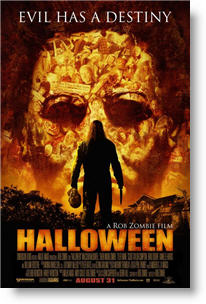
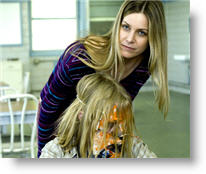
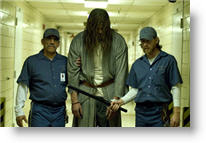
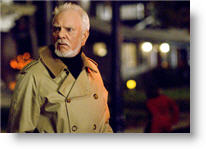
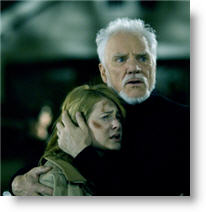
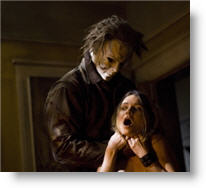
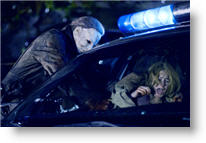

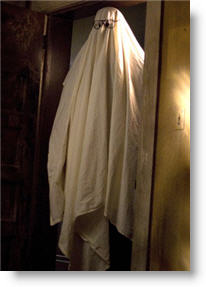
| Featuring | Malcolm McDowell, Brad Dourif, Daeg Faerch, Tyler Mane, Scout Taylor-Compton, Sheri Moon Zombie, William Forsythe, Danielle Harris, Kristina Klebe, Udo Kier, Danny Trejo, Lew Temple, Skyler Gisondo, Jenny Gregg Stewart, Hanna R. Hall, Dee Wallace-Stone, Max Van Ville, Pat Skipper, Ken Foree |
| Director |
Rob Zombie (‘The Devil’s Rejects,’ ‘House of 1000 Corpses’) / Screenwriters: Rob Zombie, John Carpenter, Debra Hill |
| Producer | Malek Akkad, Wilson Thomas Brown, John Carpenter, Andy Gould, Andrew G. La Marca, Bob Weinstein, Harvey Weinstein, Rob Zombie |
| Distributor |
 Dimension Films, a division of The Weinstein Company |
“Halloween” opens with a shot of ten-year-old Michael Myers (Daeg Faerch) in a clown mask, petting a rat named Elvis. “Pretty Elvis,” he says. A few minutes later, we see him in the bathroom, scrubbing blood off his hands. He comes downstairs and flatly tells his family that the rat has died.
The whole movie’s like that: numbed by its own horrors.
The first half details the events of one Halloween in the mid-nineties. It is a microcosm of Michael’s childhood. Over the course of the day, he is threatened and insulted by his vulgar stepfather, ignored by his promiscuous older sister, and bullied (the word almost seems too mild) by his foul-mouthed schoolmates. (This is a powerful portrayal of the kind of sick social milieu that can so easily destroy a child—but it is a mere portrayal, never quite rising to the level of condemnation.)
The only bright spots in Michael’s life are his mother (Sheri Moon Zombie)—who, despite her immoral lifestyle (she works as a stripper and, it is implied, a prostitute) and bad taste in men, genuinely loves him and tries to be a good mother—and his baby sister “Boo.”
The negative influences far outweigh the positive ones, and little Michael is a seriously disturbed child. When a school administrator discovers pictures of tortured animals in the boy’s backpack, he calls in Dr. Sam Loomis (Malcolm McDowell), who urges Michael’s mother to seek psychiatric help for her son. Michael overhears the conversation, and, in some way that is not quite explained, it sets him off. He goes out and beats one of the schoolyard bullies to death. That evening, after trick-or-treating, he kills most of his family in gruesome ways.
Michael is convicted of the crimes and placed in Dr. Loomis’s care. For a while he seems to be recovering, but then, disturbed by looking at an old snapshot of himself and Boo, he commits another murder.
This sequence of events deserves the lengthy description I have given it. It is dramatic and fascinating, with hints at real psychological insight, and contains a few scenes capable of touching the emotions. Not so the rest of the film, a perfunctory rehash of the events of John Carpenter’s 1978 original: adult Michael (former wrestler Tyler Mane) escapes from an insane asylum and terrorizes his hometown, while Dr. Loomis pursues him. This mad-slasher Michael has little in common with the tragic child of the first half; perhaps we are meant to see that he has become dehumanized, but the abrupt transition feels false.
Even before the killings begin, there’s plenty of objectionable content. Obscene language permeates the film: the F-bombs are so numerous they might better be characterized as F-shrapnel, and explicit sexual descriptions are placed in the mouths of children. A pole-dancing scene, a fairly graphic sex scene, and flashes of nudity in the first half prefigure even heavier sexual content in the second. The violence is so bloody, brutal and pervasive that it does not bear description.
The most disturbing aspect of “Halloween,” though, is that it seems calculated to show humanity at its worst. The only consistently sympathetic characters are Mrs. Myers and Dr. Loomis, and both prove ineffectual. Laurie Strode (Scout Taylor-Compton), the purported heroine of the second half, has nothing in common with Jamie Lee Curtis’s resourceful innocent in the original film. She is shallow and uninteresting, and survives through a combination of luck and unappealing brutality. Near the end, her bloodied, swollen face bears a vague resemblance to Michael’s white mask; I’m sure this was intentional.
The 1978 film ended on a note of chilling menace, but there was hope, too: the “good guys” had survived, had at least temporarily defeated the evil, and hadn’t destroyed themselves in the process. The new version has a more final ending, but still lacks a sense of closure; it is despairing and bleak, a visual wail.
The film is very well-done visually, with good compositions (albeit many of them centered on corpses) and a wise use of color. The fast cutting in the second half works on a visceral level, though it cheats the story. The music, integrating John Carpenter’s original theme with new compositions by Tyler Bates, effectively keeps the mood. Aside from a wildly inconsistent performance by Taylor-Compton, the acting is competent; Sheri Moon Zombie, in particular, shines. Yet all this polish and talent seems wasted on a flawed story with a dramatic message devoid of redemption, peace and hope.
Violence: Extreme / Profanity: Extreme / Sex/Nudity: Extreme


Extremely Offensive / 1½
The first, and probably most obvious, thing to point out about this film is the language/ dialog. Within the first ten minutes, I heard the f-word over 20 times. In fact, I do not recall a single sentence that did not use that word. I think there might even have been a sentence entirely composed of that word thrown in there. There was also a whole lot of sexuality in the dialog. Comments about masturbation, ejaculation onto women’s breasts, oral sex, prostitution, and a scene of Michael’s sister masturbating the neck of a bottle on the dining room table as she made obviously sexual groans. The older man, I assume it was supposed to be his step-dad, made a comment about the older sister’s body being attractive in a very crude manner as she walked away from the table. There were also comments directed at Michael, who is, I am guessing, around 12 or 13, calling him gay (in of course a more colorful manner) as well as calling him names and such. Again, this all within the first 10 minutes of the film.
Secondly, and this is one of the main reasons we left, was the violence. We are fans of some of the previous Halloween movies, and this was nothing like those. The first scene of the movie is an alluded to torture of one of his pet rats (The camera shows him picking up the rat followed by a scene of him washing blood off of his hands and a scalpel). He also tortures other animals and takes pictures of them. These pictures are found in his back pack by his principal along with the body of an animal in a ziploc bag. We also do not recall a single moment of torture when Michael Meyers kills his victims. They are relatively quick deaths such as a knife to the throat or a fire extinguisher to the head. But, in this film, 12 year old Michael Meyers beats the school bully with a stick. But that isn’t the half of it. He hits him a couple of times and leaves him to suffer a moment. Hits him a few more times and waits. Hits him some more, then waits some more. Then he pauses for a while, taking a picture of his mother out of the bully’s pocket (his mother is, I am guessing, an exotic dancer) and staring at it. The bully is begging for his life and suffering. Eventually, Michael gets around to killing him, obviously very slowly.
Like I said, we left at this point, but if this is any hint as to what the rest of the film is like, then I am glad we left. If images and dialog like this don’t bother you, then go right ahead and watch it. But, in my opinion, there just really seems to be something wrong with this kind of movie. It is pornographic in nature and, I would say, uncalled for.
Extremely Offensive / 2
Extremely Offensive / 1½
Average / 5
Very Offensive / 3
The Bad: This film had sexual scenes in the movie that we could have done without. The swearing and the using of God’s Name in vain was unacceptable. The sex and alcohol use made me uncomfortable and was very offensive to me. His being picked on brought back memories that were hard to think about again. The movie still could have been scary and well made without the sex scenes. If you like a good scare and love being on the edge, SEE THIS MOVIE, but BEWARE of the sexual immorality of this movie and the over-usage of God’s name in vain and the swearing.
Offensive / 4½
Extremely Offensive / 1
Offensive / 5
Offensive / 4½
Very Offensive / 1½
This, however, does not negate from the quality of the filmmaking. To his credit, Zombie (who is also the host of TCM Underground on Turner Classic Movies) made notable effort to remain true to the original plot behind the first “Halloween” film (directed by John Carpenter and released in ‘78), and sought advice from the first film’s director on how to go about maintaining the integrity of the story. Zombie’s respect for cinematic art makes him a refreshing alternative to other modern horror directors like James Wan (the Saw franchise).
Granted, this movie does not come without objectionable content. Moreover, this is not a movie I would view in mixed company at all, and I have actively discouraged my female friends from viewing it. There is graphic violence, language, and nudity throughout. Though part of the original slasher film’s purpose was to model karma (the slasher figure is often a result of the character’s behavior, as is very evident in both the original Halloween film, and the remake), there is no Earthly substitute for the justice of God, and this film contains little to no content that would suggest that God has any part in this story.
For viewers who view the movies as a medium through which to tell stories, this movie will be rewarding; it is a highly effective (and complimentary) retelling of the classic story that made Michael Myers a household name. Additionally, viewers who enjoy being scared by movies will also find satisfaction in this film. However, anyone who walks into “Halloween” expecting any kind of moral lesson or applicable virtue will be disappointed. There is none.
Extremely Offensive / 4½
Moral rating: Offensive / Moviemaking quality: 2
I think that under all of its content there is a good and notable message that Rob Zombie is trying to potray in a very raw and straight-forward manner. That the earliest years in a childs life are the most important. And that the type of person you are to the child really does matter.
There is a lot of sex, language and violence so if you go see it, do not be surprised. And only take an older teen if they are very mature and can handle the content.
Moral rating: Offensive / Moviemaking quality: 4

I think this is a great quote to use for my review of this year’s re-imaging/remake/update of “Halloween.” It is said by Dr. Samuel Loomis (portrayed by Malcolm McDowell).
…“Halloween” succeeds on a level that is equal to, and in many ways surpasses its 1978 predecessor by John Carpenter. This movie takes a more psychological approach to the main villain persona of Michael Myers; whereas the original portrayed him as a chilling, menacing, zombie-like stalker who just won’t die. Few movies have given their movie villains a more human persona and gotten away with it, but Zombie seems to have fun here. When the audience first sees Myers, he is a disturbed 10-year old boy who lives in Haddonfield, Illinois with his mother, his sister Judith, her mother’s abusive boyfriend Ronnie (William Forsythe), and baby Laurie. On Halloween night, when kids are usually out treat or treating, and having no one to go treat-or-treating with. Michael snaps and, with a kitchen knife, dispatches Ronnie, his sister, and his sister’s boyfriend. The only victim he lets live is Laurie, whom he gives to her the nickname of “Boo,” because of the fact that she represents pure innocence that Michael identifies with. Authorities take him away to Smith’s Grove Sanitarium, and assigns Samuel Loomis to be the boy’s psychologist. Fifteen years go by, and Michael escapes from the hospital just as he is about to be transported. Loomis knows where he is heading; Haddonfield. He’s going back to terrorize his now-teenage Laurie (Scout Taylor-Compton) and her friends, and will kill anyone in his path.
The movie is divided into two halves, and is seen more as a psychological horror film rather than taking a full-on slasher approach. The movie isn’t for everybody, though. There’s some heavy use of swearing, prominently in the film’s first half, graphic violence, and nudity (some of which for the movie I could’ve lived without). There are some sexual situations in the film’s second half, but one doesn’t give in to the temptations of her friends. One is asked to lie, and he ultimately gives in. At the beginning of the film, one of Michael’s first victims is a school bully who continuously harasses Michael about the fact that his mother is a stripper.
The idea of having Myers communicate as a child serves as a thrilling addition to the series. The kid who portrays Myers as a child appears very menacing to say the least, if not haunting. Through rapid editing and a little backstory, the audience can see him transform as he goes from innocence to pure evil, causing him to go into a self-catatonic state and become the Michael Myers that film buffs have come to accept. As Dr. Loomis, McDowell gives a more hardening shell in his portrayal that makes him seem embittered but a little sympathetic as he tries to understand Michael’s behavior, and Compton is believable in her screams and cries as the victim. (One of the scenes she shares with Michael is neatly choreographed and handled very well, and fits in with the innocence theme described earlier in my review.)
The director’s use of cinematography is very effective in capturing the atmospheric terror that one typically associates with Halloween night. There aren’t any scenes that jump out at you, but some of the great horror movies are usually the ones that are subtle in their appearance. And, in case you’re wondering about the iconic theme music, yes, it’s still there, with one “new” addition. “Mr. Sandman,” the song made in the 1950s and popularized by the original film’s sequel (the Carpenter-era film from 1981), gets a sturdy makeover: one that does fit and touches on all themes the movie presents; fear and innocence are the only issues that come to mind when hearing the song in this version.
My Ratings: Extremely Offensive / 5